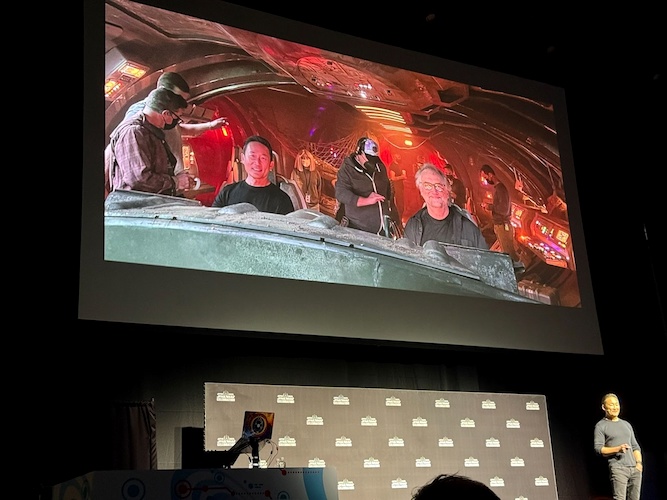Designing on the Edge: Doug Chiang on Rediscovering the Wonder of "Skeleton Crew"
At Star Wars Celebration Japan, Lucasfilm’s VP and Executive Creative Director Doug Chiang took the stage for an in-depth presentation titled Doug Chiang: Designing the World of Skeleton Crew. Reflecting on the creation of the live-action Disney+ series, Chiang gave fans a look behind the curtain at how his design team brought Skeleton Crew to life - and how it reawakened the same excitement he felt when George Lucas first hired him nearly 30 years ago.
Chiang explained that Skeleton Crew gave him the rare chance to push Star Wars design “right to the edge," just as Lucas challenged him to do during the development of the prequel trilogy. “It felt like my days back at Skywalker Ranch," he said. “We had the opportunity to expand George’s universe, just as we did back in 1995."
Chiang’s enthusiasm for the project was ignited by a single-sentence pitch from Jon Watts: An Amblin-style Lucas adventure about four kids who find an ancient spaceship in the forest. That logline instantly transported Chiang to his own childhood in Michigan, where he used to explore the woods behind his house and imagine stumbling upon a buried ship. Within two weeks, his team produced a dozen concept paintings, blending the emotional tones of E.T., The Goonies, and Close Encounters of the Third Kind with the iconography of Star Wars.
The early paintings set the tone - a Star Wars suburbia with mobile homes crafted from repurposed ships, 1980s-style hover bikes, and overgrown forests hiding mysterious vessels. Chiang said one key piece, showing the kids discovering the buried ship, “could be the movie poster for the series." The aesthetic leaned heavily into Spielberg nostalgia, complete with golden hour lighting and magical mystery. “At first glance, it could be any ordinary Spielberg film," Chiang added. “But then you notice there’s a blue elephant kid running down the street."
For Skeleton Crew, the mandate was to build everything from scratch - new ships, new worlds, and new characters. Chiang emphasized how important it was to honor the design philosophy he learned directly from George Lucas: a mix of the old and the new, the familiar and the fantastical. “Only George knows what Star Wars design really is," he said. “I do my best to follow his philosophy, though I don’t always get it right."
That philosophy became especially crucial when designing the show’s signature spacecraft: the Ironclad, a massive buried vessel that dramatically emerges from the ground. Inspired by Civil War battleships and kaiju-scale reveals, the ship rises upside down, revealing a sleeker vessel hidden within - a moment Chiang called one of his favorites in the series. The layered design required not only two ship exteriors but also an interior set that could play right-side up and upside down. “We had to figure out how to create that illusion with one set," he said, describing mirrored paneling and ceiling-to-floor control modules that flipped based on orientation.
A big part of Skeleton Crew’s appeal was its clear reverence for Spielberg’s 1980s films - and the production design made that connection explicit. One highlight was Port Borgo, a pirate hideout inspired by Spielberg’s Hook, which was designed to evoke the feeling of Neverland. Nestled within a blue nebula, the pirate cove featured docks, rowboats reimagined as transparent space dinghies (a nod to E.T.'s quarantine tubes), and swirling space clouds that mimicked the ocean. Chiang said, “The nebula emotionally evokes the quality of water and ocean... we wanted you to smell the humidity and feel the grime."
The creature designs were just as whimsical. One market stall included a small tribute to Michael Jackson’s Captain EO in the form of Fuzzball, the oddball critter that rode on EO’s shoulder. “It doesn’t make logical sense, but it has charm and personality," Chiang explained. “Sometimes we have to put logic on hold to create memorable characters."
Although Skeleton Crew used modern tech like StageCraft’s LED volumes, Chiang and his team remained committed to physical models and puppetry. The quirky pirate droid SM-33 was performed by puppeteers, while the trash monster from the Lanupa sequence was brought to life using stop-motion animation by Phil Tippett’s studio. “We could’ve done it with CG, but stop-motion brings a charm that’s hard to replicate," Chiang said. “Sometimes CG can be too perfect."
Even the animatronic head for Neel, the show’s wide-eyed alien child, was a physical build by Legacy Effects. Chiang lit up when talking about these creations. “There’s a life to these physical models. They add soul to the performance."
Chiang described the series as guided by three core values: fun, adventure, and heart. That philosophy shaped everything - from the hover bikes inspired by 1980s Schwinns, to the sprawling vaults of an underground mint hidden beneath the kids’ home planet, to the final showdown where a pirate galleon descends from the clouds like a mechanical shark. “We wanted that moment to feel like the mothership in Close Encounters, but with menace," he explained.
Reflecting on his time on the show, Chiang said working on Skeleton Crew reminded him why he fell in love with Star Wars in the first place. “Working with Jon Watts and Chris Ford pushed me out of my comfort zone in the same way George did," he said. “After 30 years, I’m still playing in George’s universe - and I’m still being surprised by it."
Star Wars: Skeleton Crew is now streaming on Disney+.
Stay tuned right here to Laughing Place for more news coming out of Star Wars Celebration 2025 in Japan, including at our live blog!




